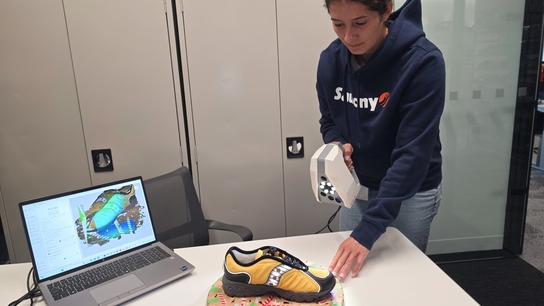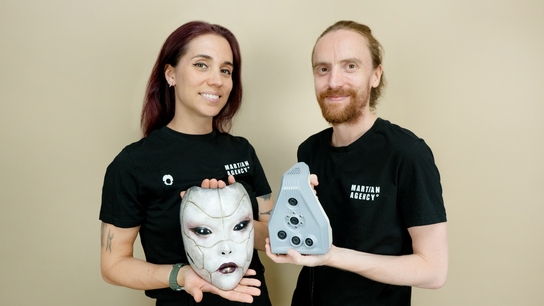Making art accessible to all with Artec 3D
Challenge: For many of us, art is something we can see and experience in any number of ways – at a gallery, on the streets, on our screens, in a book. For many others, art is inaccessible – those who are visually impaired, or those who are incarcerated, for example. The team at Watts Gallery is committed to changing that.
Solution: Artec Eva, Artec Studio, 3D printing
Result: Creating art that can be ‘seen’ in a different way – to be touched, to be taken out of shelves, to be shared.
Why Artec? Artec 3D’s handheld scanners are portable and easy to use, and safe for any surface, making capturing artwork in galleries quick, easy, and effective in providing unbeatable results.

With 3D scanning, printing, and outreach programs, the Watts Gallery team is committed to bringing art to all
George Frederic Watts, a 19th-century British painter and sculptor who was renowned for his contributions to the Symbolist movement both during his lifetime and posthumously, once famously said “I paint ideas, not things.”
Craftsperson, designer, and social reformer Mary Fraser Tytler (later known as Mary Watts) shared the same ideals and had long worked to support and employ local women who might otherwise have had little opportunity to earn a living.
It is this vision that laid the foundation of the Watts Gallery – Artists Village, tucked away in Guilford, 40 minutes south of London.
“The core belief that runs through the whole gallery in all its work,” said Emily Burns, Curator at Watts Gallery, “is the concept of art for all.”
This is something the original founders of the museum strongly believed in. “G F Watts and renowned designer Mary Watts believed in the empowering and inspiring effect of art on the world, on everyone,” said Burns. “And they didn't want it to be elitist; they wanted to make it accessible for all.”
For many of us, art is something we can see and experience in any number of ways – at a gallery, on the streets, on our screens, in a book. For many others, art is inaccessible – those who are visually impaired, or those who are incarcerated, for example. Beyond a general audience, it is to these groups among others that Watts Gallery is committed to bringing art.
When ‘Do not touch’ means ‘Do not see’
The average gallery visitor who may desire to experience art up close is typically told to stand back and keep their hands off. As the signs clearly read, do not touch. But for the visually impaired, this often makes art entirely inaccessible. When sculptures are tucked behind velvet ropes or in glass cases, the opportunity for engagement is limited to those who can see.

Do not touch: a common sign in any gallery or museum
“We work with so many different audiences of all ages,” Kate Rockhold, Community Programme Curator at the gallery, said. “And one of the avenues I decided to pursue was to work with visually impaired visitors: So, people who aren’t able to experience our art and our collection in a typical way.”
One work in particular is Clytie, one of G F Watt’s sculptures that is particularly detailed. “Clytie tells the story of a mythological ocean nymph who has fallen in love with the God of the Sun,” Rockhold explained, “and she’s made a transformation to a sunflower, which is a flower that follows the sun’s progress – so she can always watch her love as he enters and leaves the day.”
With all its intricacies, this work is surely meant to be viewed in three dimensions. “It’s very unique. It’s not a typical bust, and to explain the strain in the twist of her neck and her body at just mid-transformation is really difficult to do,” Rockhold said. Plus, “it’s made out of bronze, so we can’t touch it – our fingers leave behind residue.”
“But luckily, we have a model here.”

Visually impaired members of the audience can for the first time experience the strain of Clytie’s neck
To create this model, the original Clytie, first sculpted between 1868–75, the gallery began collaborating with Scan the World, a London collective committed to digitizing artwork in museums and galleries around the world. Hosted on and in collaboration with Google Arts & Culture, Scan the World has the largest ecosystem of free to view, share, download, and print digital cultural heritage.
“We were introduced to the Clytie sculpture by one of the workers at the museum who mentioned the Art for All project, which is a big backbone for the museum’s history and what their current digitization goals are for,” said Jon Beck, founder of Scan the World. “So we worked with them wanting to create accessible models which could be printable and put into the hands of very many different people.”
The sculpture, now one of many, was scanned with Artec Eva, a versatile 3D scanner for capturing accurate data quickly, easily, and safely.

Seeing sculptures in high-definition 3D introduces details we may have once missed
“Artec Eva has been great as most of the objects that I’m scanning are sort of around the size of your hand, or larger,” said Beck, who has so far scanned almost 3,000 works of art in collaboration with more than 60 institutions and counting. Smaller sculptures are scanned in as little as a minute, with larger sculptures taking just a half hour or less to complete.
“But what is most beautiful about the process is the software – with Artec Studio it feels like every year I’m getting a new product,” said Beck of Artec 3D’s annually released professional software. “What I find so easy about Artec Studio is that it encourages you in a very simple step-by-step way, and it will optimize the data for you.”
Once processed, a 3D model is then optimized for 3D printing and, in collaboration with the London Sculpture Workshop, printed in polymer, turned into a rubber mold, and from there, can be cast into various materials such as bronze, marble, and terracotta.

The interactive exhibition invites the audience to experience art in various textures
“To be able to have a physical model where you can feel that transformation and that movement, which is so difficult to capture in a sculpture, is really special to have,” said Rockhold. “When I first used this model [with a visually impaired group], it was really fantastic because I had talked about the work many times before – but for them, specifically to feel this part of the neck and to feel that strain, and then to feel it on their own neck, is really special.”
Another dimension of art
Another way the museum works with different communities to make art for all is through their prison program. Here, women inmates are invited not just to see and feel the art, but to create something themselves with various media including ceramic clay.
“Watts Gallery delivers a program once a week with a tutor who works with a group of up to nine women – prisoners developing their art practice,” said Sally Varah, the Chair of the Michael Varah Memorial Fund (MVMF), a small charity that works to support incarcerated persons.
The women in the program come from varied backgrounds: Their ages span three decades, and they have a range of offenses and sentences. “They come to the program with varying degrees of artistic skills: Some have not painted since they went to school, some have never painted before,” Varah said.
“With the 3D models, it’s a whole new dimension for them.”
The ability to 3D print detailed sculptures from scan data captured with Artec Eva here proved an essential tool for the program’s success.
“When I talked to some of the ladies who have been with the program, they felt that this was actually the first time that they had been able to engage almost personally with G F Watts and his work – with the 3D models, it’s a whole new dimension for them.”

Art ventures beyond the gallery, as hope shines ‘through the gates’
“For these women, this is not just a weekly program. It is a lifeline, and it makes their prison sentences survivable,” said Varah, “because particularly for women offenders who have so often had self-belief knocked out of them, it gives them a belief in themselves, and a hope that there is a life with their art in what we call ‘through the gates’.”
For the people
With all the gallery has done so far, one thing they are not doing is standing still. “Museums and galleries are not static institutions,” said Rockhold. “They’re constantly changing and evolving, and we need to adapt and be more inclusive and more welcoming to all audiences of all ages and abilities.”
“3D scanning is so great for us because it’s been a tool for us to bring art to the people.”
“3D scanning and creating these smaller, lighter, or tactile models that can be touched is really exciting for us because our sculptures, they’re big, they’re intimidating, and hard to move,” said Burns. “With these 3D models, we cannot only allow people in the galleries to engage and analyze the works within the space, but we can also take them out and do outreach work into the community and bring the works of art to the people.”
And so the foundation of the Watts Gallery continues: a dynamic, changing way to experience, be inspired by, and create art – and in this gallery, there’s room for everyone.
Scanners behind the story
Try out the world's leading handheld 3D scanners.





